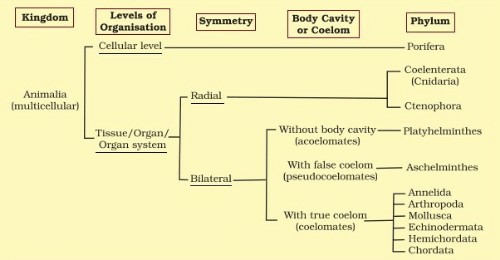Table of Contents
The Earth is home to over two million animal species. At least ten thousand new species are discovered every year. Consequently resulting in enormous number of animal species living on earth. Thus, making the animal kingdom the largest of all the five kingdoms. It is hence, important to classify each of the discovered species besides describing each of them. Classification of species results in allocating a structured position to the newly discovered species simultaneously.
This article lets you know the diverse classification of Kingdom Animalia closely and clearly. To begin with, let us understand that the branch of science that deals with classification of organisms is termed as Taxonomy. Then, let us learn about the various basis of classification of animals. Lastly, we will learn about each phylum of animal in detail.
Ace your Exam Preparation! Download Entri Today!
Basis of Classification
It is evident that there are astonishing differences between different kinds of animals. However, in spite of the differences there are some common features amongst various animal species. It may be based on the cell arrangement, body symmetry, nature of coelom and many more. Firstly, let us understand the different basis of classification of animals. Some of them are as follows:
- Level of organization
- Body symmetry
- Coelom
- Germinal layers
- Segmentation
- Notochord
Level of Organization
All the animals are multicellular and eukaryotic in nature. However, the pattern of cell organization varies greatly in different animals. It may range from cellular level of organization to the organ system level of organization, for instance.
The cellular level of organization is mostly seen in sponges. It is because of the loosely arranged cells in sponges. In organisms belonging to coelenterates, the arrangement of cells is a little more refined. Here, group of cells performing the same function are grouped as tissues. Thus, showing tissue level of organization. Furthermore, in the members of Platyhelminthes, tissues are grouped into organs. This results in organ level of organization. Also, in animals like Annelids, arthropods, Molluscs, Echinoderms and organs form organ systems. This results in organ system level of organization in them.
Body Symmetry
Animals are classified into different types based on their body symmetry. They show the following types of symmetry, namely
- Radial Symmetry
- Bilateral Symmetry

If any plane passing through the centre of the organism divides it into two equal halves, then it is called radial symmetry. It is mostly seen in coelenterates and echinoderms.
If only a single plane passing through the organism divides the body into two halves, then it is called bilateral symmetry. Annelids, arthropods and molluscs exhibit this type of symmetry.
Coelom
Coelom is the body cavity between the gut and the outer body wall. It is lined by mesoderm. Based on the presence or absence of this body cavity, animals are classified into three major types. They are as follows:
- Coelomates
- Pseudocoelomates
- Acoelomates
Coelomates are the animals with a body cavity or coelom. Annelids, arthropods, molluscs, echinoderms, hemichordates and chordates can be specifically categorized as coelomates.
In some animals, the body cavity is not covered by mesoderm properly. Instead it appears as scattered pouches. Therefore, they are known as pseudocoelomates. For instance, animals belonging to aschelminthes fall into this category.
Acoelomates are animals who lack the body cavity or coelom . Phylum platyhelminthes exhibit this characteristic, for instance.
Ace your Exam Preparation! Download Entri Today!
Germinal layers
Besides the above mentioned criteria of classification, animals are also classified based on the number of germinal layers present. The important types include:
- Diploblastic animals
- Triploblastic animals
Animals whose cells are arranged in two layers (ectoderm and endoderm) are called diploblastic animals. For example, coelenterates. While the animals which possess a third germinal layer are categorized as triploblastic animals. Animals belonging to Platyhelminthes, Annelida, arthropoda ,etc fall in this category of classification.
Segmentation
There is an internal and external division of the body into segments. It is prominently seen in animals like earthworms . This results in a series of repetition of similar organs. Therefore, animals are also classified based on this characteristic.
Notochord
Notochord is an elastic rod like structure which mesodermal cells. Moreover, it is one of the most prominent methods of classification. Animals with a notochord are called chordates. Furthermore, the animals without a notochord are termed as non-chordates.
Get Unlimited Online Mock Tests! Download Entri App!
Classification of Animals
1: Who was the first woman President of India?
As we have looked onto the basis of classification, let us now understand the animal kingdom classification in the adjacent sections of this article. Each category of animal is represented by the term ‘Phylum’. An illustration of the different classification of animals is shown below.

Let us now sum up the 11 major Phylas as in the list below:
- Porifera
- Coelenterata
- Ctenophora
- Platyhelminthes
- Aschelminthes
- Annelida
- Arthropoda
- Mollusca
- Echinodermata
- Hemichordata
- Chordata
Phylum Porifera
All the members of this phylum mostly exhibit the cellular level of organization. The word ’Porifera’ refers to pore bearing organisms/species. Hence, this phylum generally consists of sponges.
Some common examples are Sycon, Euspongia and Spongilla
Characteristics of Phylum Porifera:
- They live in marine water. However, there are fresh water sponges also.
- Loosely arranged cells are present in the body
- They have a cylindrical body shape. This results in a water transport or canal system in their bodies.
- Presence of ostia in their body. These are numerous pores throughout the body.
- The mode of digestion is intracellular.
- They are hermaphrodites. (no separate sexes)
- The sponging fibres supports the body
- Reproduction takes place asexually by fragmentation and sexually by gamete formation.
Phylum Coelenterata (Cnidaria)
There are approximately 11,000 species of aquatic animals under this pylum. The word ‘Cnidaria’ derived from the term cnidoblasts /cnidocyts. Cnidocyts are specialized cells in the body which can sting other organisms. It is mainly used for capturing prey. However, it is used for anchorage and defense also.
Examples include Physalia, Adamsia, Aurelia, etc
Characteristics of Phylum Coelenterata:
- They are aquatic animals (mostly marine)
- The body exhibit radial symmetry and a tissue level of organization.
- Two layers of cells make up heir body. Hence are diploblastic animals.
- The digestion is intracellular and extracellular.
- They have a gastro-vascular cavity with a single opening.
- There are mainly two body forms, namely, Polyp and medusa.
- Reproduction takes place asexually by budding. However, a few coelenterates show sexual mode of reproduction.
- Respiration and excretion is by simple diffusion.
Phylum Ctenophora
The animals belonging to this phylum are commonly called as sea walnuts or comb jellies. As a result of their characteristic features, they belong to the group of lower invertebrates.
Examples include Pleurobrachia and Ctenoplana.
Characteristics of Phylum Ctenophora:
- They are marine animals.
- The body is radially symmetrical and diploblastic in nature.
- They exhibit tissue level of organization.
- The body bears 8 rows of ciliated comb plates. Consequently, it helps in locomotion of the animal.
- Digestion can be Intracellular or extracellular .
- They show bioluminescence according to which the living organism emits lights from its body.
- Sexes are not separate.
- Reproduction takes place only sexually. Furthermore, it involves a larval stage.
Phylum Platyhelminthes
The animals of this phylum have a flattened body. Hence they are usually called flatworms. Some of the species of this phylum are endo parasites. For instance, the human digestive system has a familiar intestinal parasite called the tapeworm (taenia)
Examples : Taenia (tapeworm), Fasciola (liverfluke)
Characteristics of Phylum Platyhelminthes:
- They are triploblastic and acoelomate animals.
- The body shows bilateral symmetry.
- Most of the species are either parasitic or free living.
- They exhibit organ level of organization.
- The body possess hooks and suckers in parasitic forms. Hence they absorb nutrients directly from the host body.
- Specialized cells known as flame cells are present. This subsequently leads to osmoregulation and excretion.
- No separate sexes.
- Fertilization is internal. Furthermore, it includes many larval stages also.
- Some of the organisms possess high regeneration capacity. Planaria, for instance.
Phylum Aschelminthes
The body of these animals appear circular in cross-section. Thus , they are called roundworms. They may be either parasitic or free living in nature.
Examples: Ascaris, Filaria worm, hook worm
Characteristics of Phylum Aschelminthes:
- They may be aquatic or terrestrial animals.
- The body is bilaterally symmetrical.
- Their bodies lack a true coelom. Therefore, they are pseudocoelomate animals.
- They possess an organ – system level of body organization.
- Presence of a well- structured alimentary canal.
- The excretory tube removes the waste from the body through the excretory pore.
- Sexes are separate.
Phylum Annelida
These animals have a metamerically segmented body. Therefore, they are called Annelids (In Latin, annulus means a little ring).
Examples: Hirudinaria (Blood sucking leech), Nereis, Pheretima (earthworm).
Characteristics of Phylum Annelida:
- Organisms may be aquatic (marine and fresh water) or terrestrial.
- They are mostly free living; sometimes parasitic.
- Their body possess a true coelom. Therefore, are coelomates.
- The body exhibits organ system level of organization.
- They are triploblastic animals.
- The body has devoted muscles which helps in locomotion.
- They have a fully developed circulatory system and digestive system.
- The sexes may or may not be separate.
- Nephridia are the excretory organs.
Phylum Arthropoda
More than two-thirds of all the named species on earth belong to Phylum Arthropoda. Therefore, it is the largest Phylum of Kingdom Animalia. Furthermore, insects also belong to this large Phylum.
Examples: Apis (Honey bee), Bombyx (silk worm), Anopheles(mosquito), Limulus(King Crab)
Characteristics of Phylum Arthropoda:
- These animals are triplobastic, segmented and coelomate.
- The body shows organ system level of organization and are bilaterally symmetrical.
- A chitinous exoskeleton covers the entire body.
- They have jointed appendages throughout the body. This helps in locomotion.
- Respiratory system may include gills, book gills, book lungs or tracheal system.
- They have sensory organs namely eyes and statocysts.
- Malphigian tubules are present for excretion.
- They are dioecious animals. In addition, fertilization is mostly internal.
Phylum Mollusca
This is the second largest Phylum in the animal kingdom, next only to arthropods. The phylum name evolved from the term’mollusc’, meaning soft. Their bodies are usually soft. Therefore they are called molluscs.
Examples: Pila, Dentalium, Octopus
Characteristics of Phylum Mollusca:
- They are terrestrial or aquatic (marine or fresh water) animals.
- The body is bilaterally symmetrical, triploblastic and coelomated.
- They exhibit an organ system level of organization.
- A calcareous shell covers the body. Also, it has a distinct head, muscular foot and visceral hump.
- They have a fully developed digestive, respiratory and circulatory system.
- The nervous system comprises of ganglia and nerves.
- They are mostly dioecious and oviparous animals.
Phylum Echinodermata
The bodies of these animals have an endoskeleton of calcareous ossicles. Therefore, they look spiny bodied. And hence the Phylum name.
Examples: Asterias(star fish), Echinoidea (sea urchin), Holothuroidea (sea cucumber)
Characteristics of Phylum Echinodermata:
- They are exclusively marine animals.
- Their bodies are triploblastic and coelomate. Apart from this, they show organ system level of organization.
- The adult echinoderms are radially symmetrical whereas the larvae show bilateral symmetry.
- A water vascular system is present in the body. Subsequently this helps in locomotion, capturing prey and respiration.
- A well defined digestive system is present. It has a mouth and anus. However, an excretory system is absent.
- Reproduction takes place sexually with an external fertilization.
Phylum Hemichordata
These animals were earlier regarded as a sub phylum of Phylum Chordata. However, they are classified as non- chordates now.
Examples: Pterobranchia, Acorn worm, Graptolithina
Characteristics of Phylum Hemichordata:
- They are marine animals with organ system level of organization.
- The body is bilaterally symmetrical, triploblastic and coelomate.
- Respiration takes place through gills.
- The body is usually cylindrical. Furthermore, a proboscis, a collar and a long trunk are present in the body.
- Circulatory system is open type whereas the excretory organ is the proboscis gland.
- They have separate sexes. Moreover, they show internal fertilization and indirect development .
Phylum Chordata
The animals in this phylum have a distinct notochord, a dorsal nerve chord and pharyngeal slits. Therefore, it includes all the vertebrates and many invertebrates also. In addition, they are bilaterally symmetrical, triploblastic and coelomate animals with an organ system level of organization.
There three sub phyla of Phylum Chordata , namely
- Urochordata
- Cephalochordata
- Vertebrata
Characteristics of Sub Phyla Urochordata:
- Notochord is present the larval stage. However, it disappears in adults.
- A tunic encloses the adult animal body. It is made of tunicin (a cellulose like substance). Therefore, they are also called as tunicate.
- Examples: Salpa, ascidia, Doliolum.
Characteristics of Sub Phyla Cephalochordata:
- Notochord is present both in larval stage and in adult animal.
- Well- developed pharyngeal slits are present in the body.
- Examples: Branchiostoma (Lancelet)
Characteristics of Sub Phyla Vertebrata:
- Notochord is present in the embryonic stage. However, a vertebral column replaces the notochord in adult animals.
- They have a muscular heart with two, three or four chambers.
Furthermore, there are seven distinctive classes to Sub Phylum Vertebrata. They are:
- Cyclostomata
- Chondrichthyes
- Osteichthyes
- Amphibia
- Reptilia
- Aves
- Mammalia
In brief, classification of animals is a truly vast kingdom on its own. Apart from helping us to identify and name all animals on earth, it helps us to know their characteristics and uniqueness. All thanks to the scientist, Carolus Linnaeus for developing this system of classification of Kingdom Animalia!
Ace your Exam Preparation! Download Entri App!











